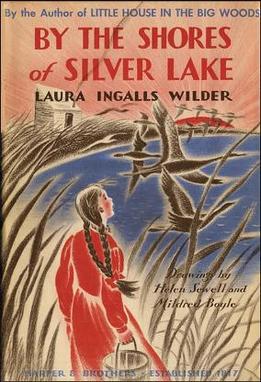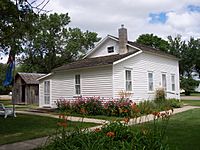By the Shores of Silver Lake facts for kids

Front dust jacket, first edition
|
|
| Author | Laura Ingalls Wilder |
|---|---|
| Illustrator | Helen Sewell and Mildred Boyle Garth Williams (1953) |
| Country | United States |
| Series | Little House |
| Genre | Children's novel Family saga Western |
| Publisher | Harper & Brothers |
|
Publication date
|
October 20, 1939 |
| Media type | Print (hardcover) |
| Pages | 260 |
| OCLC | 6932095 |
| LC Class | PZ7.W6461 |
| Preceded by | On the Banks of Plum Creek |
| Followed by | The Long Winter |
By the Shores of Silver Lake is a children's book written by Laura Ingalls Wilder. It was published in 1939. This book is the fifth in her famous Little House series. It tells the story of Laura's life for just over a year. The story begins when she is 12 years old. Her family moves from Plum Creek, Minnesota, to what will become De Smet, South Dakota.
This novel was recognized as a Newbery Honor book in 1940. Several other books in the Little House series also received this award.
Contents
The Story of the Ingalls Family
This book is based on Laura's real childhood. It starts in 1879 near De Smet, South Dakota. Laura's older sister, Mary, had recently become blind. This happened because she got sick with scarlet fever. Pa asked Laura to "be Mary’s eyes." This meant Laura would describe everything she saw to Mary. This helped Laura become more patient and grown-up. The book also introduces Laura's youngest sister, Grace.
Leaving Plum Creek
The story begins in Plum Creek, Minnesota. The Ingalls family had just recovered from scarlet fever. Aunt Docia came to visit them. She suggested that Pa could work as a bookkeeper. This job was at Uncle Henry's railroad camp. He would earn fifty dollars a month, which was a lot of money then.
Mary was still too weak to travel far. So, Pa went ahead with their wagon and horses. The rest of the family would follow later by train. The morning Pa was leaving, their old bulldog, Jack, sadly died in his sleep. This made Laura very sad.
A New Adventure by Train
Several months later, Ma and the children traveled to Dakota Territory. They went by train. This was their very first train trip! They were excited about this new way to travel. A train could cover in a few hours what a horse and wagon would take a whole day to do.
Pa met them in town. The next day, they all went to the railroad camp. Laura and her cousin, Lena, played together after finishing their chores. Their chores included collecting laundry and milking cows. Laura even rode a horse for the first time on Lena's pony!
Winter in the Surveyors' House
As winter got closer, the railroad workers tore down their camp buildings. They all went back east. The Ingalls family had nowhere to stay. They planned to go back east too. But then, the surveyors, who planned to stay for winter, were called back east. They asked the Ingalls family to stay in their house. In return, the Ingalls would watch over their surveying tools.
Laura was thrilled to move into the beautiful house. It was full of supplies. Later, Mr. and Mrs. Boast, who were newly married, arrived during a snowstorm. They stayed past Christmas. For New Year's, the Ingalls visited the Boasts' small home for dinner. Mrs. Boast shared her newspapers with Laura. She also showed them how to make a what-not shelf.
A Dream for Mary
Later that winter, Reverend Alden visited them unexpectedly. He learned that Mary was blind. He told Ma about a college for the blind in Iowa. Laura decided then that she would become a teacher. She wanted to earn money to help send Mary to that college.
One clear winter night, Laura and Carrie went for a moonlight walk. They walked on the frozen lake. They saw a wolf! The next day, Pa went hunting for the wolf. Instead, he found the perfect piece of land for their family. He planned to claim it at the land office. This would happen as soon as the weather improved.
A New Home in De Smet
Pa's trip to the land office was delayed. Many men moving west also needed to stay in the surveyors' building. The money the Ingalls earned from boarding these men was later used for Mary's college education. After Pa returned from Brookings, he built a store building in town. This was so his family could move when the surveyors came back. The book ends with the Ingalls family settling into their new home. It was a cozy shanty on their new land.
Life on the Prairie: Historical Facts
To encourage people to settle in the middle of the United States, Congress passed the Homestead Act in 1862. This law divided unsettled land into sections. Heads of families could claim a piece of land for very little money.
What was a Homestead Claim?
A section of land was about 1-square-mile (2.6 km2; 640-acre). A claim was ¼ of a section, which was 160 acres. Thirty-six sections made up a township. Each section had a special number. For example, it might be the NW quarter of Section 18, Township 109, Range 38.
For just $10.00 plus other small fees, a person could get 160 acres (0.65 km2) of land. But they had to live on it for five years. They could not give up and move back east. The Ingalls family had claimed land near Plum Creek before. In the spring of 1880, Charles Ingalls filed a homestead claim. It was south of De Smet. This claim was for the NE quarter of Section 3, Township 110, Range 56.
Book vs. Real Life
Some small details in the book are a bit different from real life. For example, Laura probably never visited the railroad grade herself. But in the book, she went there with her father. She also wrote that the surveyors left food in the house for the Ingalls. However, other stories say it's not clear if Pa had to buy the supplies for winter. Authors sometimes change small details to make a story better.
Visiting the Little House World Today
Today, De Smet, South Dakota, is a popular place for fans of the Little House books. Many historic sites from the novels are there. These include places from By the Shores of Silver Lake, The Long Winter, Little Town on the Prairie, These Happy Golden Years, and The First Four Years. The Ingalls family lived in De Smet from 1879 to 1894.
You can visit their homestead. There's also a house in town that Pa built. You can see the Brewster School where Laura taught. And the surveyors' house where they lived between 1879 and 1880 is also open to visitors.
More Little House Stories
Besides the original Little House books, there are many other books. Some series tell stories about five generations of Laura's family. The success of these books has led to many related stories. There are "Little House Chapter Books" and "My First Little House Books." These tell the original stories in a shorter, simpler way for younger readers.
Other authors have written more series. These tell the stories of Laura's mother (The Caroline Years), grandmother (The Charlotte Years), great-grandmother (The Martha Years), and daughter (The Rose Years). There are also Little House-themed craft books, music books, and cookbooks.


